Splendid self-isolation opportunity for civilisation
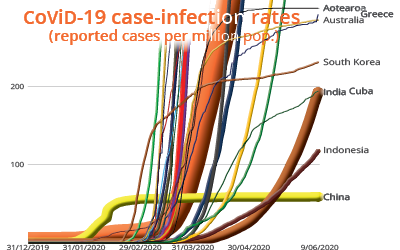
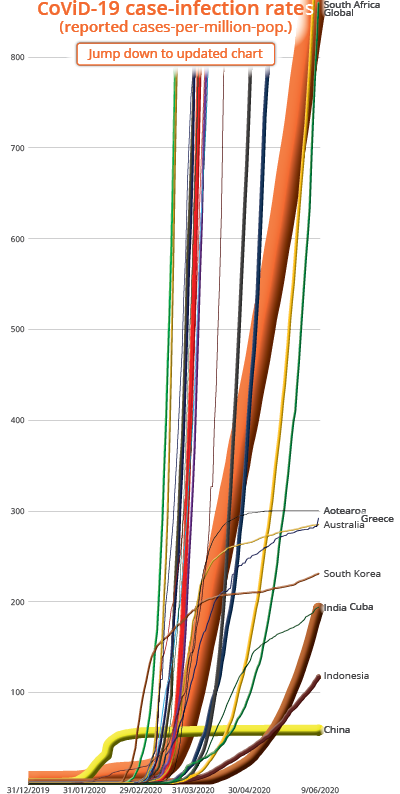
Unflattening the Curve: For those frustrated by graph after graph displaying reported covid-19 infection rates, or deaths, with, for mere mortals, a deceptively curve-flattening logarithmic vertical scale, this chart graphically illustrates how, for most countries other than China, the hard work and tragedy still lies ahead. The limitation of its lineal vertical scale also graphically attests to the horror of Italy’s rampant case infection rate, now surpassed by Spain, whose rate currently would require this graph to be six times as tall—or Singapore’s trajectory, having squandered its trumpeted initial efforts. Embarrassingly, it took until 3 April to notice that the graph was monumentally under-representing the United States’ soaring infection rate. graph Mahurangi Magazine | data ecdc – nzmoh 9 June 2020
Having squandered more than two months of protection and preparation time, the challenge for civilisation now is to break its determined habit of wasting every crisis in its entirety.
Aside from abiding by Prime Minister Jacinda Ardern’s succinct advice to act as though one has covid-19, and stay strictly scrupulously self-isolated, most New Zealanders can do little to directly assist those on the front line of the pandemic, from pulmonologists to police, to supermarket order fillers, or indeed the victims.
There are, however, myriad ways to not waste a crisis such as the covid-19 pandemic. The proximate compelling cause, of course, is the pandemic itself, and the first need is to learn from those who study epidemics and pandemics, and particularly seasonal influenzabecause a more robust response to the annual scourge of influenza would greatly improve resilience to all coronavirus and non-coronavirus epidemics and pandemics. Even viewing Netflix’s astonishingly prescient Pandemic is not a complete waste of time. Whether, in total, the docuseries will disabuse more anti-vaccine zealots than it recruits is moot, but the scales might begin to fall from the eyes of some of anti-vaccine inclination.
There are powerful reasons, in the first four weeks of self-isolation, to study the existential threat of jet-travel-powered pandemics to a largely unvaccinated population of 7.8 billion. However, the currently slower-burning crisis of anthropogenic global heating demands a modicum of attention be given its business-as-usual guarantee of killing billions and savagely impacting the lives of all but a powerful and heavily armed few. In a time of crisis, societal reticence, and even scientific reticence, invariably results in the bull elephants in the room being studiously ignored. Despite being described formally in 1969Latané and Rodin (1969), the bystander effect continues to suppress a rational response to crises. Clearly, since early-January, the world needed to have been placed on high alert. Travel, particularly international travel, should have been strongly advised against. At the same time, the role air travel plays in spreading viruses, but even more existentially problematic, the role it plays in delivering an unsurvivable climate, should have had the world’s governments warning that international travel, increasingly, will need to be done via fibre-optic cable, rather than airliner. And nor will tooth-fairy, battery-powered airliners alter this reality.
While the case for re-engineering the world from covid-19 outwards can robustly be made, pandemics are just one impact that civilisation must adapt to. Even the 1918 Pandemic killed, at most, 5.5% of global population. If the world’s likely greenhouse-gas-emissions trajectory results in 6–7° of heating by 2100, the projected 11.2 billion population will be fortunate indeed to be culled by as little as 55%, much less 5.5. The preparedness of China, then other countries, to lockdown cities, regions and entire countries, even belatedly, could be cause for hoping that business-as-usual thinking will no longer be a totally insurmountable barrier to salvaging a survivable climate.
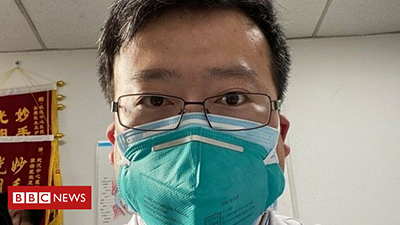
December Warning: When whistleblower Dr Li Wenliang died on 7 February, the outbreak since-named covid-19 had 31 491 reported cases and reported 638 deaths, worldwide. As of 28 March, the reported figures are 596 366 and 27 344 respectively. Meanwhile, the developing world has barely begun to quantify and report cases, and even Aotearoa is seriously under-reporting, given it is in a deplorably early stage of testing. image bbc
Manifestly, many countries would have gone into lockdown sooner but for concerns about tanking their chronically business-confidence-dependent economies. Donald Trump’s asinine talk of New York, a covid-19 hotspot experiencing exponential infection rates, to be “opened up, and just raring to go, by Easter” epitomises the incipient, economy-before-people mind-set. From a post-2100 perspective, such utterances are going to appear utterly incomprehensible. But that aside, with what has been known about the consequences of fossil fuel combustion since 1988, civilisation should have been so engaged with building zero-carbon infrastructure that business confidence, long since, had become a bagatelle. The projects would have been there waiting for workers to resume the second a lockdown was lifted.
China will have to wear, and deserves to wear, approbation for failing to immediately share evidence of an emerging novel coronavirus with the global community. But that delay was in the order of weeks, whereas governments worldwide have prevaricated for months. Even the World Health Organisation waited about a month too long, until 11 March to declare covid-19 a pandemic, three days after it had already spread to more than 100 countries. It is deeply ironical that most, on beginning to hear about the emerging novel coronavirus, readily embraced the social-media-rampant disinformation suggesting that, in comparison with the seasonal influenza, any deaths would be trifling. Ironic on two fronts: The first being that most of those seasonal deaths were avoidable, had governments resourced the measures long since known to be effective—fewer than a fifth of children and adults globally appear to be receiving flu shots. The first of those requires a few simple behaviour changes around reducing contact between face and hands, and between the face and hands of other people, certainly between the face and hands of individuals not normally intimate daily.
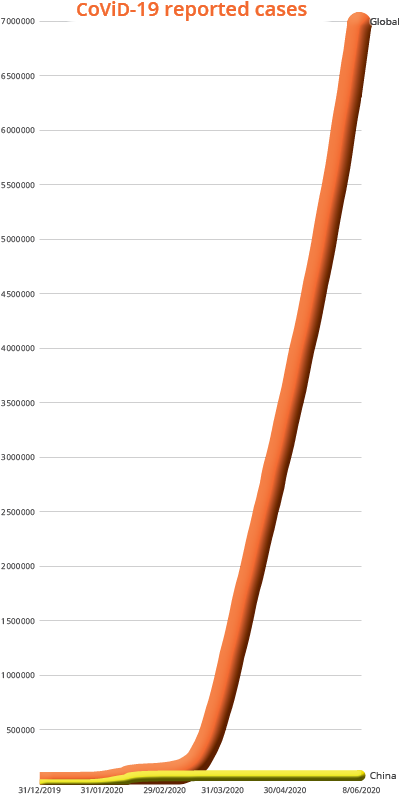
Hockey Stick Axis of Evil: Hideously, even before covid-19 is contained globally, the axes of this chart has swapped in length—the blade of the hockey stick becoming its shaft. The plot of China’s cases demonstrates what the rest of the world could have achieved, had it promptly locked down and energetically followed the who entreaty to test, test, test. Cases for all countries other than China are almost certainly significantly under-reported, including those of Aotearoa, thanks to its deplorable delay in testing. graph Mahurangi Magazine | data ecdc 8 June 2020
The second measure, of course, is vaccination against seasonal influenza, free, and for all. The third measure, which is, up there with habitual unsanitary touching, is the advice few follow, which is to stay away from workplaces and schools, and other people, when infectious with seasonal colds and flu: self-isolation. But the other front on which suggesting novel influenza, in the context of seasonal flu, should be of no particular concern was problematic is that the prevalence of flu inevitably masks any emerging novel viruses, robbing the epidemiologists tasked with detecting potential pandemics of crucial time. In short, taking seasonal flu much more seriously is a win-win-win, in reducing its awful toll, and reducing the spread of, and detection time for, an emergent novel influenza. Given its profound human and economic impact, estimates of the average annual costs of influenza should be readily available. On the contrary:
It appears that a decade has passed without global quantification, but:
Given that the human and economic impact of covid-19 is already projected to be in the trillions of dollars, flu is making fools out of humanity’s pathological unpreparedness to see the big picture, and to plan accordingly. Short-termism rules, and seldom in the interests of other than the rich and powerful. Growth, whether by totalitarian regimes or the nominally democratic, is seen as imperative, and consumerism is encouraged by both. The curiously circular argument that population growth must not be addressed because faster growing countries have a lower per-capita carbon footprint must immediately be confronted. At 7.8 billion, Planet Earth is demonstrably long-past dangerously overpopulated. With anthropogenic global heating already rendering regions uninhabitable, the projected 11.2 billion population by 2100 will be cataclysmic for humanity and its fellow species.
Aotearoa is indexed as a full democracy, fourth-placed amongst 10 other such-rated countries, which collectively make up a miniscule 1.6% of global population. Even then, the Economist’s respected index is overly-generous. Aotearoa has poor and declining voter turnout, serial electoral-finance-law fraud, no comprehensive voting-in-schools programme, and its politicians still adhere to two-party, pre-1994-proportional-representation thinking. This was shamelessly demonstrated on 23as originally erroneously published: 22 March March when Prime Minister Jacinda Ardern marred her otherwise stellar lockdown announcement by rejecting out of hand, an emergency grand-coalition government. During what is escalating to become the most devastating pandemic sincethe 1957–1958 flu pandemic killed 1–4 million people, and possibly including 1918, there is no moral or practical excuse for a party elected by 29% of registered voters to exclude a party that received 35%, from a national-emergency coalition government. Given their country was the world’s first democracyfirst democracy where franchise was not conditional upon ethnicity or gender, New Zealanders should not be content with not being on the podium. Ironically, 27th-placed Estonia, which has had the stones to defy the world’s voter-suppression, anti-online-voting disinformists, will likely be the only democracy to not suspend elections this year.
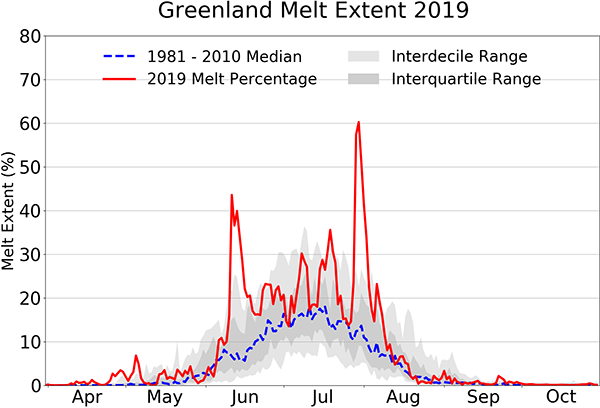
Fire, Ice and Influenza: Rather than leave it to historians to attempt to explain how yet another civilisation went from seemingly eternal to collapsed, this time in the space of just a few human generations, humanity needs to use this lockdown to take stock of the mountain of cans it can no longer kick down the road. Record wildfire in Australia to the 2-month, 600-gigatonne 2019 Greenland ice-melt, underlines the perverseness of the preoccupation with bailing out businesses and activities that, all too soon, will be making pandemic deaths look trifling. Now is not the time for kneejerk, all-of-the-above responses to restart the economy at all costs; that was the enduring tragedy of the Barack Obama presidency, post 2007–2008. chart National Snow and Ice Data Centre | Thomas Mote, University of Georgia
Humanity, it has to be said, is poorly served by its international governance structures, which wield far less power than the corporate world. Gordon Brown, whose one term as the United Kingdom’s prime minister spanned the Great Recession, has reportedly called for:
The fact that intergovernmental efforts, after 32 years, have conspicuously failed to reduce greenhouse-gas emissions isn’t justification for Brown’s call being rejected. Surely, what makes anthropogenic global heating the super-wicked problem is the perceived lack of immediacy. Ironically, the global community has relatively readily grasped the urgency of responding to covid-19 without needing the same hockey-stick-shaped graph that has left most people more interested in cramming as many luxuries, epitomised by air-travel, onto their high-carbon bucket lists as they can conceive. The acid test as to whether the world learns from this escalating pandemic will be if global governance is made fit-for-purpose, and it puts science ahead of economic dogma:
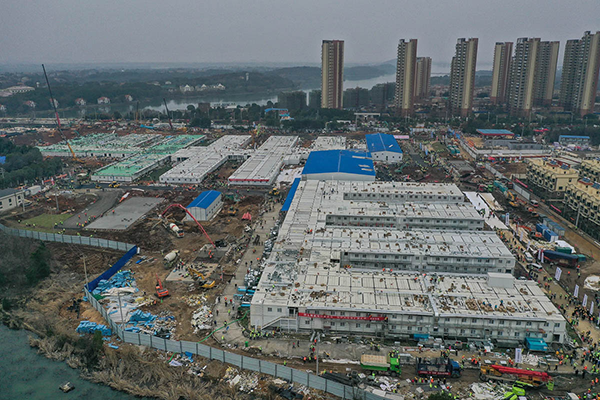
Not for the First Time: In operation in under 11 days from beginning of construction, on 3 February, Wuhan’s Huoshenshan Hospital demonstrates what it took to bring covid-19 swiftly under control in China. Hospitals in Aotearoa struggle to cope with seasonal influenza, never mind a virus at least 14 times as deadly, and highly infectious to boot. Huoshenshan—and Leishenshan, which opened six days later—benefitted from Xiaotangshan, in Beijing, built in seven days in 2003 in response to the sars epidemic, which infected 8098, and killed 774. image Aljazeera
Those legions putting their lives on the line caring for the infected, and testing those who might be, not to mention the legions of others providing other essential services, deserve to have their sacrifice respected by world’s economists admitting to the damage done by their zombie neoliberal monster. That chickens—or in this metaphor, batsor, as seems increasingly apposite, pangolins—have come roost en masse should permanently demote the dismal science, to the supporting role it should never have been permitted to rise above. The covid-19 pandemic is demonstrating just how ultimately costly, to take but one example, a failure to decently and sustainably house people is. Playing to its strengths, Aotearoa could easily be the world’s most successful manufacturer of engineered-timber, high-cube-shipping-container-dimensioned modular buildings that could have doubled hospital and quarantine beds, and clinics, overnight. A country with a proud history of innovation, not excluding respiratory care, should long since have addressed its shameful housing shortage that sees people sleeping in cars, garages, and rough, using—rather than carbon-emitting steel-reinforced-concrete-slab relics—carbon-sequestering timber from fast-growing planted forests.
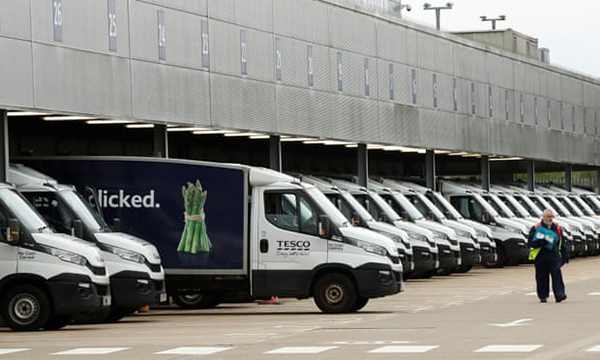
Taking a Long Time to Get Dark: Having taken a decade too long to build for the future of low-carbon, online-ordered, home-delivered groceries, New Zealand’s supermarkets are now scrambling to go dark. image The Guardian
Aotearoa, and the developed world generally, is dangerously car-centric; car-dependent. Aside from inequality considerations, continuing to build-in car-centricity is an energy, and carbon, catastrophe. covid-19, however, has exposed another, more immediate, deadly down-side to car-centricity: Food distribution, long since, should have evolved beyond the supermarket model. Meantime:
With their supermarket delivery and click-and-collect services hopelessly overwhelmed, New Zealanders otherwise fastidious about remaining within their bubbles are being forced out to forage in the flesh, putting themselves and others at utterly unnecessary risk. This, of course, is just one of the preparations that Aotearoa should have taken—along with robust, crises-ready testing-laboratory capability—and the real test of leadership now is whether, in concert with governments worldwide, this avoidable global crisis results in concerted, comprehensive climate mobilisation, beyond mere commissions and targets.
Achilles’ Heel of current strategies The following are the two concluding paragraphs of Asymptomatic Transmission, the Achilles’ Heel of Current Strategies to Control Covid-19, published 28 May 2020:
Ultimately, the rapid spread of Covid-19 across the United States and the globe, the clear evidence of SARS-CoV-2 transmission from asymptomatic personsArons MM, Hatfield KM, Reddy SC, et al. Presymptomatic SARS-CoV-2 infections and transmission in a skilled nursing facility. N Engl J Med. DOI: 10.1056/NEJMoa2008457, and the eventual need to relax current social distancing practices argue for broadened SARS-CoV-2 testing to include asymptomatic persons in prioritized settings. These factors also support the case for the general public to use face masks when in crowded outdoor or indoor spaces. This unprecedented pandemic calls for unprecedented measures to achieve its ultimate defeat.

Becoming Wise Before the Event: Despite now experiencing 17 pandemics—and 6 of those since 2002—the world was found to be pitifully ill-prepared for when, with predictable unpredictability, this current pandemic manifested. Preparing for the potentially far-deadlier effects of anthropogenic global heating, as well as being an inescapable existential imperative, can, simultaneously, better equip humanity to respond to epidemics, and prevent more becoming pandemics. Here, the initially all-but-imperceptible case-infection rates displayed for India and Indonesia were grave indicators of governments in desperate denial of their countries’ now-destined roles in the raging pandemic—and early exemplar Singapore demonstrates the ruinous consequences of neglecting its most vulnerable workers. Nigeria, however, scams all 207 million of its citizens, by testing fewer than 1% of them, thus hiding the appalling impact of the pandemic there. Australia long-since lost her battle to keep within cooee of covid-19-test-kit-exporter extraordinaire South Korea’s standout response. Aotearoa, meantime, has flat-lined in a good way. All countries’ infection rates are under-reported, some because a few cases, particularly early in the pandemic, are misdiagnosed, but in other countries monstrously, due to dysfunction and/or lack of transparency. The diameter of each line on this graph is proportional to the country’s population. graph Mahurangi Magazine | data Our World in Data 12 November 2020
Join FluTracking now and help prevent future pandemics…
Salutary Lesson in Seasonal Influenza: Physical distancing has also paid dividends in reducing the annual toll extracted by flu that, despite its deadliness, is treated as an inconvenience rather than the killer it is, particularly of the very young, the elderly, and the pregnant—“On average, approximately 400 deaths are attributed to influenza and its complications annually.” covid-19 provided the opportunity to begin collecting flu-symptom data earlier than was done 2018–2019. graph Department of Health Australia | Ministry of Health Aotearoa | labels Mahurangi Magazine
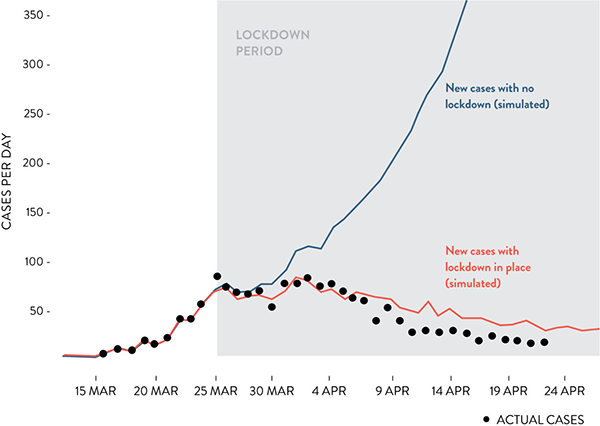
New Zealand’s Altered Future: Moving nine days faster than Ireland, and more emphatically physically distancing, Aotearoa has avoided Ireland’s near vertical trajectory—until the middle of May—of reported covid-19 cases. Ireland’s prime minister then donning his sweats was perhaps great optics, but responding to, for example, fellow general practitioner Dr Marcus de Brun, or to nursing-home representatives more than seven weeks earlier, would have constituted a far more heroic course of action. Aotearoa, for its own survival, now needs to convince the world to alter its determinedly fossil-fuelled future. chart New Zealand Geographic | Te Pūnaha Matatini

It seems feasible for New Zealand to eliminate the virus given we are an island and the current controls are reducing it.
However, we are an economy heavily dependent on tourism and I am not sure how this could continue to prosper given that the tourists will come from countries that still have it. Perhaps Kiwis will have to holiday at home and not abroad. Even if there is a successful vaccine for the advanced economies, it will not be used worldwide. Even our flu vaccine is not taken by everyone here, in spite of its wide availability, and free for the vulnerable.
Indeed Julian. Embracing the maxim of not wasting a crisis, now, or at least when we are back at the lowest alert level, investment can be commenced in the hugely more sustainable tourism industry—compatible with reduced greenhouse-gas emissions—that we should already have been evolving. Rail with trail, is but one example: Visiting Aotearoa for All the Right Reasons